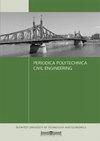轻混凝土包覆冷弯型钢受压模型的等效弹簧法评估
IF 1.4
4区 工程技术
Q3 ENGINEERING, CIVIL
引用次数: 0
摘要
采用混凝土填充和支撑是改善冷弯型钢构件稳定性能的重要途径之一。一个例子是由CFS包裹在超轻质混凝土中的新型建筑系统。使用实体有限元对这种结构构件进行数值分析非常耗时,因此需要一种易于使用的建模技术。因此,引入了一种简单的、具有时间效率的等效弹簧模型(ESM),作为在许多情况下正确分析复杂结构行为的可行方法,用单向弹簧代替混凝土实体,应用Winkler基础。本研究旨在通过将ESM与三维实体模型(SMOD)结果进行比较,来检验ESM的有效性和局限性。分析结果表明,在PAC模量(50 ~ 250 MPa)的大范围内,ESM可以在b/t≤100的范围内提供精确的结果,误差小于5%;因此,在这些限制范围内使用弹簧建模PAC是可以接受的。然而,对于较大的b/t值高达175,强烈建议将计算的弹簧刚度加倍。结果表明,当b/t大于175时,ESM的适用性有限;该模型无法预测最终失效载荷和失效模式。最后,本研究最后推荐了一个计算内部组件等效基础弹簧刚度的公式,以确保ESM分析的最佳性能。本文章由计算机程序翻译,如有差异,请以英文原文为准。
Assessing the Equivalent Spring Method for Modelling of Lightweight-concrete Encased Cold-formed Steel Elements in Compression
Using concrete for filling and bracing is one of the most crucial ways to improve cold-formed steel (CFS) elements' stability behavior and performance. An example is the novel building system made up by CFS encased in ultra-lightweight concrete. The numerical analysis of such structural members using solid finite elements is time-consuming, thus the need for an easy-to-use modelling technique has arisen. As a result, a simple time-efficient equivalent spring model (ESM) has been introduced as a viable method for properly analyzing complex structural behavior in numerous cases, replacing the concrete solid with one-directional springs applying the Winkler foundation. This study aims to examine the validity and limitations of the ESM by comparing it to 3D solid model (SMOD) results for internal plate elements. The analysis results indicate that the ESM could provide accurate results in the b/t range of 100 or less for a wide range of PAC modulus (50–250 MPa) with an error of less than 5%; hence, using spring in modelling PAC within these limits is deemed acceptable. Nevertheless, for larger b/t values up to 175, doubled the calculated spring stiffness is highly recommended. In addition, the results reveal that the applicability of ESM is limited for b/t above 175; the model fails to predict the ultimate failure load, and the failure mode. Finally, this study ends by recommending one equation for calculating equivalent foundation spring stiffness for internal components that ensure optimal performance of the ESM analysis.
求助全文
通过发布文献求助,成功后即可免费获取论文全文。
去求助
来源期刊

Periodica Polytechnica-Civil Engineering
工程技术-工程:土木
CiteScore
3.40
自引率
16.70%
发文量
89
审稿时长
12 months
期刊介绍:
Periodica Polytechnica Civil Engineering is a peer reviewed scientific journal published by the Faculty of Civil Engineering of the Budapest University of Technology and Economics. It was founded in 1957. Publication frequency: quarterly.
Periodica Polytechnica Civil Engineering publishes both research and application oriented papers, in the area of civil engineering.
The main scope of the journal is to publish original research articles in the wide field of civil engineering, including geodesy and surveying, construction materials and engineering geology, photogrammetry and geoinformatics, geotechnics, structural engineering, architectural engineering, structural mechanics, highway and railway engineering, hydraulic and water resources engineering, sanitary and environmental engineering, engineering optimisation and history of civil engineering. The journal is abstracted by several international databases, see the main page.
 求助内容:
求助内容: 应助结果提醒方式:
应助结果提醒方式:


